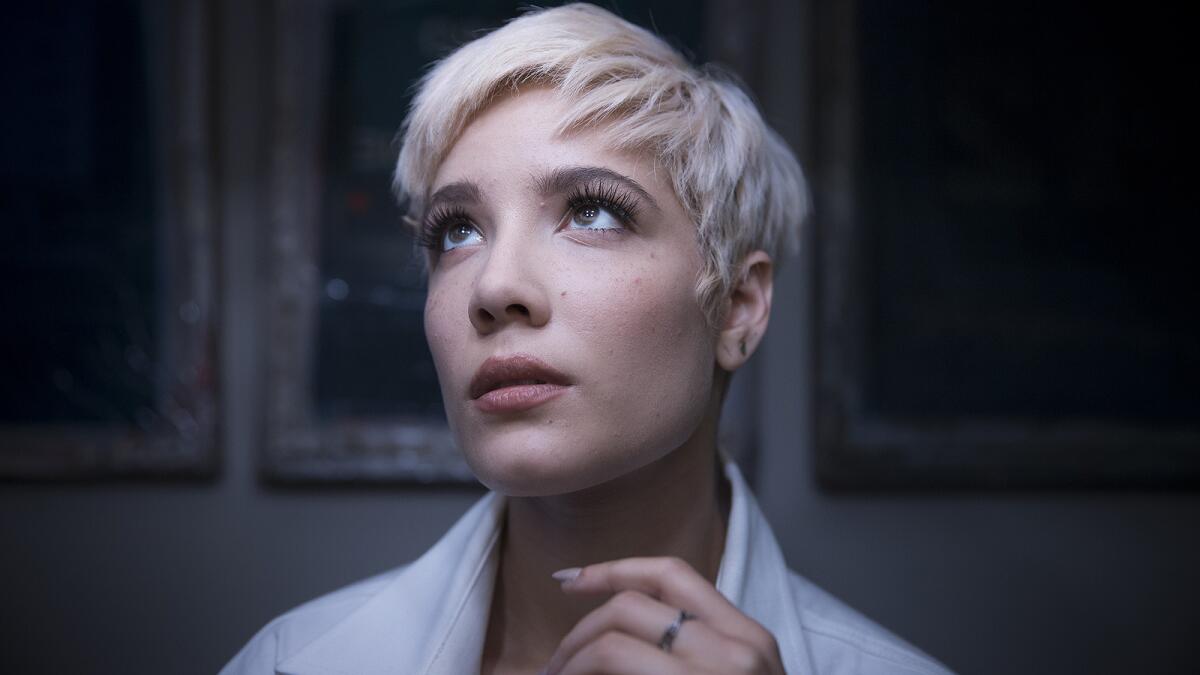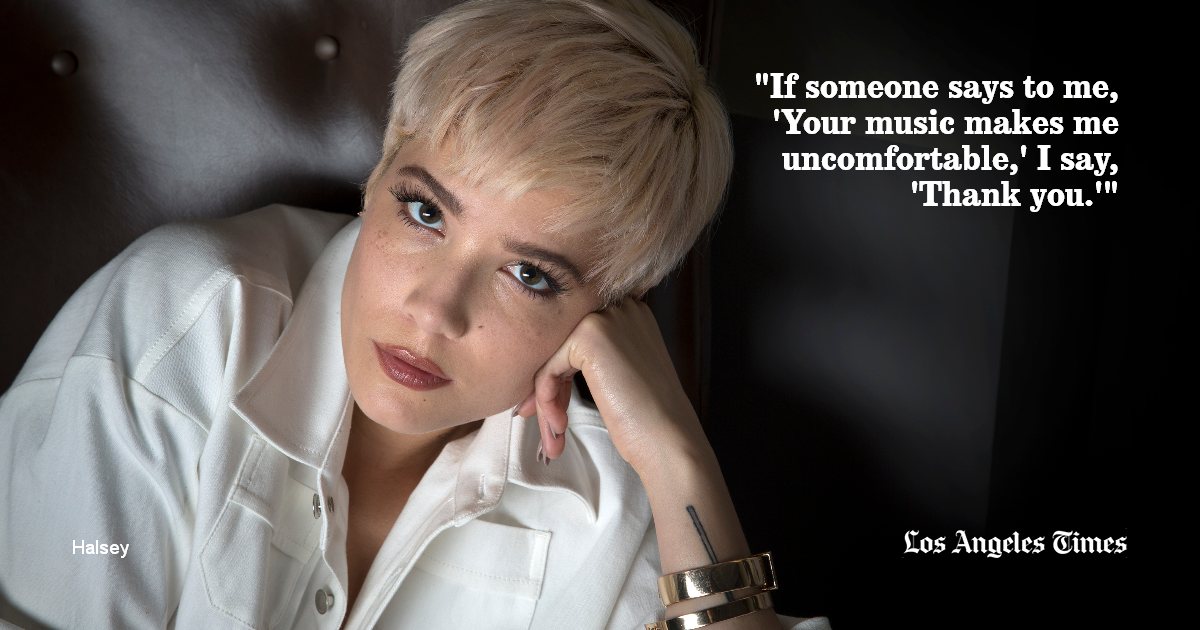Halsey on her connection with her fans: ‘I’m like a fixer on steroids’

Pop singer Halsey at the Roosevelt Hotel in Hollywood.
- Share via
One of music’s most talked-about new artists, Halsey has come a long way in the four years since she left home at age 17.
The singer, known for her confessional yet provocative lyrics, recently passed the million-follower mark on both Twitter and Instagram. She won over Zane Lowe, the influential DJ on Apple’s Beats 1 radio station with her song “New Americana.” And in September, her debut album, “Badlands,” entered the Billboard 200 chart at No. 2 with impressive sales of nearly 100,000 copies.
SIGN UP for the free Essential Arts & Culture newsletter >>
In at least one respect, though, Halsey — born Ashley Nicolette Frangipane — still sees herself as the kid who moved out of her parents’ house to live with a boyfriend whose drug problem she thought she could help him beat.
“I’m a fixer, unfortunately,” she says. “I’m like, ‘Oh, I can fix you.’ But it’s not just guys I’m dating anymore. It’s this entire legion of young girls who tell me they need me to maintain any sort of sanity or peace.”
She laughs wryly.
“I’m like a fixer on steroids.”
She’s flexing new muscles to prove it too. Having built a fiercely devoted core fan base, Halsey, 21, is making a clear push toward the mainstream with a high-profile duet on the new album by Justin Bieber and an opening slot on the Weeknd’s fall arena tour, scheduled to stop Tuesday at the Forum in Inglewood.
Yet in a sign of how pop now sometimes moves from the bottom up, she’s attempting to get there while preserving the proud-misfit vibe embodied by songs like “Castle,” in which she’s “sick of being poised,” and “New Americana,” about a generation “high on legal marijuana, raised on Biggie and Nirvana.”
“You can be accessible without catering to an audience,” she says just hours after flying in from New York following an early morning performance with Bieber on the “Today” show. Wearing a button-down shirt-dress the same color as her icy-blond hair, the singer adds that unsettling a listener in this era of media overstimulation — getting a person to feel her thoughts on mental illness or the emptiness of celebrity — is something to strive for, not avoid.
“If someone says to me, ‘Your music makes me uncomfortable,’ I say, ‘Thank you.’”
Halsey experienced that reaction to art early in her own life. Growing up in suburban New Jersey, she spent a lot of time in after-school programs while her young parents worked, she says. Reading came quickly, and by sixth grade she’d consumed classics from well beyond any elementary curriculum: “The Great Gatsby,” “Death of a Salesman,” “Lolita.”
“I got exposed to all this stuff — sex, betrayal, the conditions of life — but had no context for understanding it,” she recalls. So she began devouring psychology textbooks she’d pick up secondhand.
“I was obsessed with learning about social behaviors,” she says. “I remember explaining to my mom that kids on my soccer team were fighting because of dyads and triads.”

Halsey
Soon she was writing prose and poetry but turned to writing songs when she decided she wasn’t getting enough attention. Like many digitally savvy musicians her age, she quickly developed a following on social media, even as she found herself drifting among friends’ couches in Brooklyn. (The boyfriend into hallucinogens didn’t last.) “Ghost,” her first single as Halsey, circulated widely enough that several record labels came calling, including the Capitol Music subsidiary Astralwerks, which signed the singer last year.
Working with a crew of up-and-coming producers, Halsey was meticulous in the creation of “Badlands,” taking care to realize her sonic vision — electronic pop with jagged edges and “a real sense of place” — and to represent her point of view as the bisexual daughter of a white mother and a black father. The effort paid off: “Badlands” is vivid and bracing, full of would-be anthems that turn personal detail into the stuff of group catharsis.
Halsey’s ability to speak to (and for) marginalized people — her songs also grapple with a history of bipolar disorder — has led some in the media to pigeonhole her, she says.
“They call me ‘tri-bi’ — bisexual, biracial, bipolar — as if I call myself that,” she says, scoffing. “I wouldn’t trivialize my existence into a hashtag.”
She complains too that only one news organization reported that she’d sold out an upcoming headlining date at New York’s Madison Square Garden — whereas dozens posted images from a recent Playboy photo shoot.
That’s the nature of pop stardom, of course, especially for a woman. And Halsey, who’s set to appear at the Forum again on Dec. 12 for KROQ-FM’s Almost Acoustic Christmas, knows how restrictive the business can be.
“There’s a reason we have a Taylor Swift, an Ariana Grande, a Beyoncé,” she says. “Everyone has to fill these narrow roles, and they can’t overlap.” Halsey’s success is in part because of gatekeepers’ perceived need for a “manic pixie dream girl,” she says, using a popular phrase that describes a quirky, straight-talking female archetype.
Yet the singer is confident that listeners — those who view her as a spokesperson and those she’s only now reaching — are more flexible in their understanding.
Watching video of her and Bieber’s “Today” performance, in which the two got intimate while singing “The Feeling,” Halsey says she was struck by the crowd’s happy acceptance of “me with my short hair, wearing boys’ clothes, having Justin Bieber caress my face at 7 o’clock in the morning.”
She laughs. “They didn’t want to see him with some girl in a little dress.
“Am I gonna take advantage of that and say what I have to say? Absolutely.”
More to Read
The biggest entertainment stories
Get our big stories about Hollywood, film, television, music, arts, culture and more right in your inbox as soon as they publish.
You may occasionally receive promotional content from the Los Angeles Times.











